The Okavango Delta in Botswana is one of the world’s largest inland deltas. While most river deltas usually lead to an ocean, the Okavango River empties onto open land, flooding the savanna and creating a unique and ever-changing inland delta.
Our first close animal sighting came as we dropped off the other passenger flying with us at her camp. They were baboons sitting quietly in the tree right outside the plane window.
Across its 9,320 square miles, the Okavango Delta is very flat, varying just six feet in height. The delta swells almost three times in size between March and August. It fluctuates between 3,728 square miles to approximately 9,320.
The diverse ecosystem supports an incredibly wide spectrum of wildlife, ranging from large herds of buffalo, wildebeest and zebra, to the red lechwe antelope, lion, leopard and packs of wild dog in the open grasslands.
It was spacious and allowed us to relax between safari activities and sleep comfortably in the evenings.
It was set along a long pathway where each tent provided plenty of privacy, with outdoor decking and secluded views.
It was our first chance to truly see some of the amazing wildlife that we were about to spend the next two weeks seeing.
Another crocodile - comes from two Greek words meaning “pebble” and “worm,” and they refer to the rough scales of the crocodile’s hide.
Spur Winged Goose - The Spur-Winged Goose is the largest waterfowl found in Africa and the largest species of goose in the world.
Elephants rely heavily on their bonds with other elephants as having a healthy social network is critical for their survival.
Fish Eagle - A fish eagle’s toes are coated in sharp barbs, called spiricules, which consequently help it to grasp fish and other slippery prey.
Hippos usually live in groups (or “herds”) of around ten to 20 individuals, led by one large dominant male. The other members are females, their young and a few young non-breeding males.

That evening back in camp after dinner, we sat around the "bush tv" and enjoyed the fire and conversation with the one other guest at the camp and MJ the Associate Camp Manager
This is a view from the Common Area of the camp looking our across the floodplain. In the distance you can see elephant grazing.
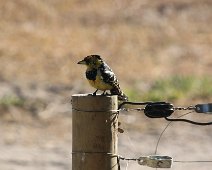
Crested Barbet on the camp fence. Barbets are known to be very vocal birds. Their call is extremely noisy and comprises of them jerking the head or tail.
They are mostly nocturnal animals that usually conceal themselves by day in brush or thickets and sally forth at dusk to hunt.
it feeds largely on invertebrates during the wet season and small mammals, such as the springhare, in the dry months.
Blacksmith Plover - The vernacular name derives from the repeated metallic 'tink, tink, tink' alarm call, which suggests a blacksmith's hammer striking an anvil.
Baboons - we learned on this trip that the easiest way to tell the difference between a baboon and a monkey is to look at their tail. If it goes up and then down, it is a baboon. If it goes straight down without going up, it is a monkey.
The African elephant is the largest animal walking the Earth. Their herds wander through 37 countries in Africa.
Burchell’s zebra ( sub-type of Plains Zebra), seen in abundance on the grasslands, has additional faint stripes superimposed on the white and referred to as shadow stripes.
Southern Ground Hornbill - Southern ground hornbills' booming calls are so loud they are sometimes mistaken for the roaring of lions.
Springbok - Male - Springbok can jump 6.5 to 9 feet from the ground. Series of consecutive leaps, known as "pronking", provides information about animal's surroundings, sends olfactory messages (from the glands near the heel) and advertises strength of animal.
Kudu - Female - Kudu are highly alert and notoriously hard to approach. When they detect danger – often using their large, radar-like ears – they give a hoarse alarm bark, then flee with a distinctive, rocking-horse running motion.

Wild Dog - It is the most threatened carnivorous animal. As of 2018, there were approximately 4500 left.
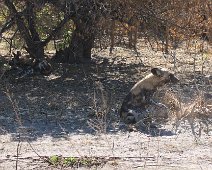
A favorite hunting tactic is to force their prey towards bodies of water such as rivers and lakes. The likely outcome is that the prey will panic and run towards the pack of wild dogs instead of entering the water which is deep and filled with crocodiles.
The species lives in groups which usually consist of an alpha male and female and the pair’s offspring. The pack hunts using teamwork, pursuing its prey–usually a medium-sized antelope–until it tires.
Giraffe weigh up to 2,200 pounds, and have a unique gait due to their weight and higher center of gravity.
Giraffes only need 5 to 30 minutes of sleep in a 24-hour period! They often achieve that in quick naps that may last only a minute or two at a time.
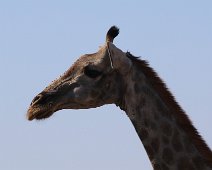
The pattern of a giraffe’s coat is fixed for life, making it possible for human observers to distinguish one animal from another; however, animals do tend to get darker with age.
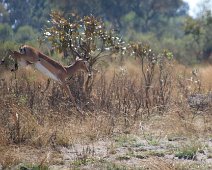
The impala is one of the most common and most graceful of all Africa’s antelopes. A slender, agile creature, it can clear formidable obstacles and run at speeds faster than 37mph.
The impala is reddish-brown with white hair inside the ears, over each eye and on the chin, upper throat, underparts, and buttocks. A narrow black line runs along the middle of the lower back to the tail, and a vertical black stripe appears on the back of each thigh.
A full day in the bush meant the wonderful people from Kadizora brought lunch out to us. Here they are grilling steaks over an open flame.
While lunch was being prepared, I was free to take photos of the abundant wildlife all around us. Here are zebras, a crocodile and egrets.
Because we had such a hard day riding around in our safari vehicle , the camp team set up bean bag lounge chairs for us to "rest" in. Here you see Sharon and our camp mate Caleigh Faure.
African Jacana - The males are expert single dads, as they care for the chicks alone. They tend to all nesting duties from nest building to bringing up the chicks.
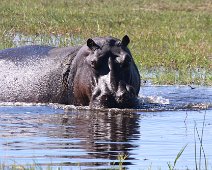
To stay cool in the blistering African heat, hippos spend most of their day in rivers and lakes. Their eyes, nose and ears are located on the top of their head, which means they can see and breathe whilst submerged in the water.

Hippos are most active at night, when they forage for food. They are herbivores, and eat mostly grass – and boy do they eat grass! In just one night, they can guzzle down up to 77 pounds of their favourite grub!
Despite their enormous size, hippos are great swimmers and can hold their breath for up to five minutes underwater. When completely submerged, their ears and nostrils fold shut to keep water out.
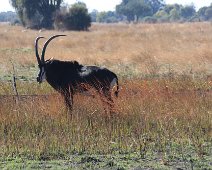
Sable Antelope - Male - Sable grow their horns over an entire lifetime. Each year they develop a new ring, so the sable’s horns can be used to determine age.
Humans are the Sable antelope’s only real threat. The giant sable antelope subspecies is listed as endangered because of trophy hunting and habitat loss.
Elephants are a keystone species. They carve pathways through impenetrable under brush shaping entire ecosystems as they create pools in dried river beds and spread seeds as they travel.
Elephants can recognize themselves in a mirror, and also passed a body awareness test. These two tests are very rarely passed by non-primates.
An elephant's memory is so good that it not only recognizes all the members of its own clan, but even other creatures who leave a strong impression on them.
Red Lechwe - Male - Their hind legs are longer and more powerful than the front legs, helping them to make huge leaps through the watery or marshy terrain. They have widely splayed hooves so as not to sink into the mud.
Tawny Eagle - Like all eagles, the tawny eagle flies at great heights. They fly on average at between 1,968 and 14,760 ft high and they are experts in gliding without flapping for a long time.
Red Hartebeest - Male. The name Hartebeest was thought to refer to the heart shaped curve of the horns but the accepted theory now is that it comes from the Dutch word hert which means deer in Dutch and beest meaning beast.
Wildebeest a the animals best known for the "Great Migration" The Great Migration refers to the continuous movement of vast numbers of wildebeest accompanied by large numbers of zebras and gazelles searching for food and water between Tanzania and Kenya.
The leopard is the most elusive and secretive of the large cats. They are extremely difficult to trace and locate in the wild.
We found this Leopard as he was watching a large herd of Impala. He took a quick run at them but they were aware of him and long gone before he went very far.
Leopards are fast felines and can run at up to 36 mph! They’re super springy, too, and can leap 20 feet forward through the air – that’s the length of three adults lying head to toe!
They are able to climb trees, even when carrying heavy prey, and often choose to rest on tree branches during the day.
This leftover meal was apparently quite old as the Leopard had to work quite hard to make it edible.

Termite Mound - Termites are extraordinary engineers, capable of building mounds standing as tall as 40 feet high and 60 feet wide and continue to build on the same mounds for centuries.
Impala - Female. Most young impala are born around mid-day as this is the safest time to give birth since most of their enemies are resting. Half of newborn are killed by predators within the first few weeks of life.
Ostrich - Male. Ostriches are the fast runners of any birds or other two-legged animal and can sprint at over 44mph.
Secretary Bird. The secretary bird is a bird of prey. Its most distinctive feature is the 20 black crest feathers stuck behind its invisible ears. The bird gets its name from these feathers that look like the quill pens 19th-century office workers used to tuck behind their ears.
A family of Elephants. The Elephant is one of the so called Big 5 animals, an old hunters term given to the 5 most dangerous animals to hunt in Africa.
Even though the lion is sometimes referred to as the “king of the jungle,” it actually only lives in grasslands and plains.
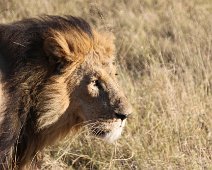
A good gauge of a male lion’s age is the darkness of his mane. The darker the mane, the older the lion.
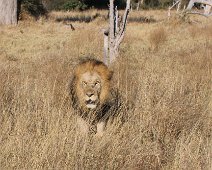
While most cats have slit pupils, lions actually have round pupils instead. It’s thought that this is because lions need to hunt for larger prey than domesticated cats, and those who may generally hunt around for smaller bites. This can also help them hunt better at night, making lions some of the best nocturnal hunters in the feline world.
No other big cats have the fabulous hairstyles male lions are famous for. That’s right – a lion’s mane is completely unique to its species. In fact, the thicker the mane, the more likely a lion is going to find a mate.
Lion territories are famous for being absolutely massive. For example, you could find a lion territory that extends up to 100 square miles in size.
Lions tend to pull down their prey by snatching at their ankles, meaning that they will often reach out for a scratch.
The stripes of the zebra help to camouflage it in its grassland habitat, which makes the animal difficult to spot from a distance.
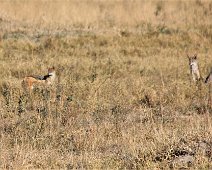
Two Side-striped Jackals - Jackals can best be described as opportunistic omnivores. They hunt small mammals, bird, reptiles and amphibians, scavenge from kills made by larger animals, and will eat insects, fruit and plants.
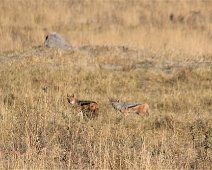
Jackals live singly or in pairs, and are sometimes found in small packs. Life in pack ensures protection against predators and ensures cooperative hunt which results in killing of the larger prey. But their most common social unit is a monogamous pair.
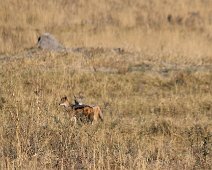
Jackals are very territorial and monogamous pairs will fiercely defend their territory from intruders.
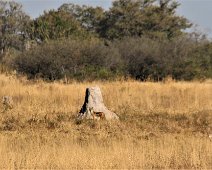
The ancient Egyptians believed a jackal-headed god, Anubis, guided the dead to those who judged their souls.
Impalas decrease their chances of attack when living in herds. They leap and scatter in all directions when being attacked to confuse the predator.
We went back to check on the male lion pair. We noticed one of the brothers had a large wound on his rear leg.
Blue Wildebeest migrate as many as 1000 miles each year – that’s longer than the length of Britain and around the same distance from Minnesota to Louisiana.
Impala - Male - Male impalas have Lyre-shaped and ringed horns, up to 30 inches long. The male’s horns can take many years to reach full length, which is why young animals are unlikely to establish a dominant position and breeding territory.
Often different types of animals can be seen grazing together for protection. Each brings its own special skills and together cover more options to alert them all when needed.
Giraffes only need to drink once every few days. Most of their water comes from all the plants they eat.
Both male and female giraffe have horns already at birth. These ossicones lie flat and are not attached to the skull to avoid injury at birth. They only fuse with the skull later in life.
To protect the giraffe’s brain from sudden changes in blood pressure when it lowers its head to drink, it has valves to stop the back-flow of blood and elastic-walled vessels that dilate and constrict to manage flow. NASA has done research on the blood vessels in giraffe legs to get inspiration for human space suits.
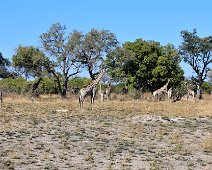
Female giraffe give birth standing up. Their young fall about 6 1/2 feet to the ground and can stand up within an hour of birth.
A giraffe heart weighs approximately 11 kilograms and is the biggest of any land mammal. It is used to pump 60 litres of blood around its body every minute at a blood pressure twice that of an average human.
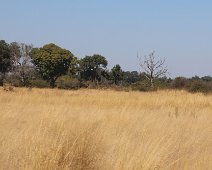
This was called Lion Grass by our guide because it looks like the flowing mane of a lion. Thatch Grass is used throughout Africa as roofs for houses.
Elephants spend up to 18 hours a day feeding and adult bulls can consume more than 550 pounds of vegetation per 24-hour period and need about 42 gallons of water.

Here is Sharon seated in front of Ken in a Mokoro. Traditionally mokoro’s were used by the local people of the Okavango Delta to traverse and fish amongst the water channels.

The mokoro safari usually entails a guide standing at the back (stern) of the boat using the Ngashe Pole to steer and propel the boat forward, whilst one or two guests sit at the front of the boat relaxing and enjoying the view. Caleigh Faure joined us in her own Makoro.

Sharon is ready for our "Sundowner". This is a tradition on safari to stop and have drinks and snacks while you watch another gorgeous sunset.
Following a safety briefing and demonstration of the boarding and landing procedures for the balloon, we were ready for take-off!
The pilot could easily maneuver us up or down using the liquid propane fueled flame, but we were at the mercy of the prevailing winds as to our direction.
This Blue Wildebeest does not need to migrate vast distances as there is still plenty of water available.
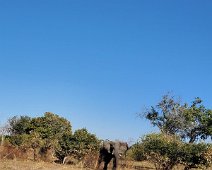
As we drove back to our camp to get ready to fly out to our next destination, we came upon this bull elephant in Musth.
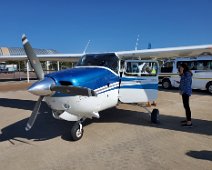
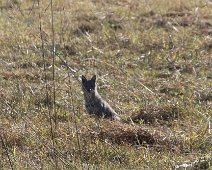

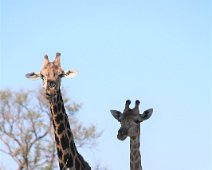
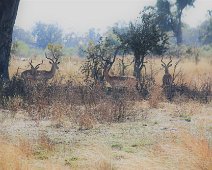
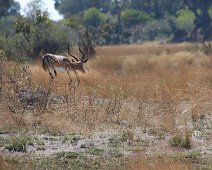
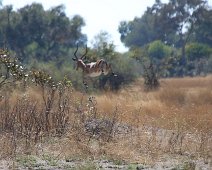

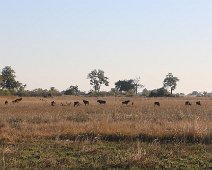
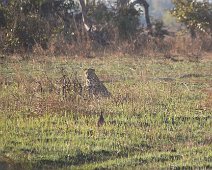
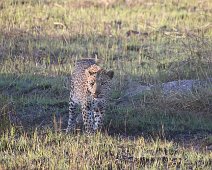
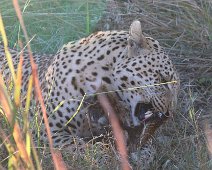


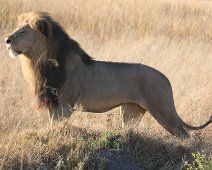
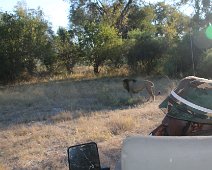

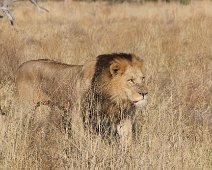
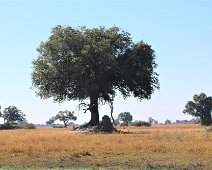

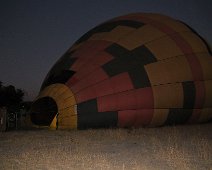
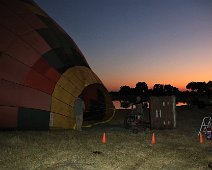

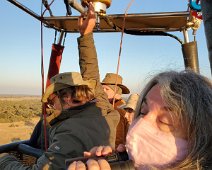

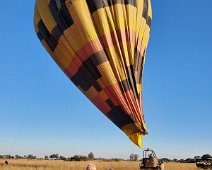


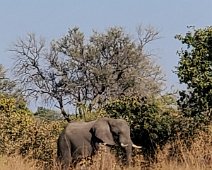
Botswana - Kadizora